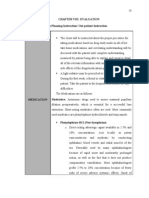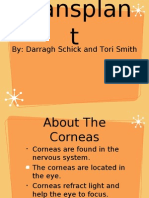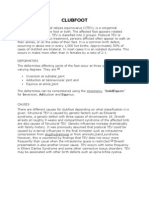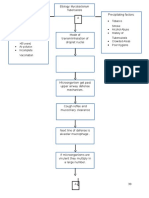Summary of The Alberta Clinical Practice Guideline, August 1996
Summary of The Alberta Clinical Practice Guideline, August 1996
Uploaded by
malathiCopyright:
Available Formats
Summary of The Alberta Clinical Practice Guideline, August 1996
Summary of The Alberta Clinical Practice Guideline, August 1996
Uploaded by
malathiOriginal Description:
Original Title
Copyright
Available Formats
Share this document
Did you find this document useful?
Is this content inappropriate?
Copyright:
Available Formats
Summary of The Alberta Clinical Practice Guideline, August 1996
Summary of The Alberta Clinical Practice Guideline, August 1996
Uploaded by
malathiCopyright:
Available Formats
Guideline for Surgical & Non-Surgical Management of Cataract 2007 Update
EW
R EVI in the Otherwise Healthy Adult Eye
DER
UN Summary of the Alberta Clinical Practice Guideline, August 1996
Diagnosis and • No single test adequately describes the effects of cataracts on visual status.
Visual Acuity • Snellen acuity is the most universally used index of visual functioning.
• Snellen acuity is the best predictor of appropriateness of surgery.
Management • During early cataract development visual improvement may be achieved through:
• Change in prescription for spectacle lenses.
• Use of strong bifocals.
• Magnification aids.
• Appropriate illumination.
• Surgery is justified when subjective, objective and educational criteria are met.
Subjective
• The patient’s own assessment of visual disability.
• The patient’s perception of the impact of their disability on life-style.
• The patient’s complaints of disabling glare.1
Objective
• The eye examination confirms that the cataract is the limiting factor for improving visual
function and other factors do not preclude improvement following surgery.
• The patient’s medical and mental health should permit surgery to be performed safely.
Educational
• The patient should be educated about the risks and benefits of cataract surgery and
alternatives to treatment.2
Other • Two other indications for cataract removal are:
Indications for Lens Induced Diseases
Cataract • Documented evidence of the presence of lens induced diseases (phacomorphic glaucoma,
Removal phacolytic glaucoma, etc.) is necessary prior to cataract removal.
Because of sight threatening complications, cataract surgery may be urgent.
The Need to Visualize the Fundus
• It is necessary to visualize the fundus in an eye that has the potential for sight or when other
special investigations demonstrate intraocular pathology where further attention is important
and requires clear media.
One-eyed • A one-eyed patient is defined as one who has permanent legal blindness in the other eye
Patients • The ophthalmologist has the obligation to inform and educate this patient about the risk of
total blindness when considering the benefits of cataract surgery.
• The worse the vision in the fellow eye, the greater the need for caution when considering
cataract surgery in the eye to be operated.
Contraindications • Surgery should not be performed under the following circumstances:
to Surgery • The patient does not desire surgery.
• Glasses or visual aids provide satisfactory functional vision.
• Surgery will not improve visual function.
• The patient’s life style is not compromised.
• The patient is medically unfit.
• The patient has had a cataract removed in one eye which has not sufficiently healed to
warrant the surgical removal of cataract in the second eye.
Notes:
1. Glare testing and contrast sensitivity testing are methods designed to correlate objective findings of cataract
formation with subjective visual loss and complaints.
2. In patients with visual acuity that is marginally reduced, the risk of surgery relative to the expected
benefit should be reemphasized to the patient.
For complete guideline refer to the TOP Website: www.topalbertadoctors.org
Administered by the Alberta
Medical Association
Preoperative ♦ Ensure that the criteria for cataract surgery are met
Evaluation ♦ Ensure that the patient has a general medical history and physical examination as appropriate for
the planned surgery and type of anesthesia
♦ Ensure that appropriate keratometry and A-scan measurements have been performed if an IOL is
to be implanted
♦ Select appropriate IOL power when IOL implantation is planned
♦ Review and discuss results of pre-surgical and diagnostic evaluations with patient
♦ Make the patient aware of any other eye disease that may affect the prognosis for visual
recovery.
Surgery ♦ Phacoemulsification cataract extraction with implantation of a posterior chamber IOL is the
current procedure of choice
♦ Anesthesia of the eye can be obtained with topical, peribulbar, retrobulbar, or general anesthesia
Hospitalization ♦ Operative complications of an ocular or medical nature are possible indications for hospitalization
• Ocular complications can include hyphema, uncontrolled elevated intraocular pressure,
threatened or actual expulsive hemorrhage, retrobulbar hemorrhage, severe pain or other
ocular problems requiring acute management or careful observation
• Medical complications include cardiac instability, a cerebrovascular episode, diabetes mellitus
requiring acute management, uncontrolled nausea or vomiting, acute urinary retention, acute
psychiatric disorientation, or other medical conditions requiring acute management or careful
observation
♦ Possible indications for planned postoperative hospitalization include:
• Presence of medical conditions that require prolonged post operative observation by a nurse
or skilled personnel
• Best correctable vision in the unoperated eye is 6/60 (20/200) or worse
• Patient is mentally debilitated or diagnosed as mentally ill
• Patient is non ambulatory or cannot exercise self care (or responsible care is unavailable)
during the immediate postoperative period.
Discharge ♦ Prior to discharge, post surgical care should be discussed with patient. Written postoperative
instructions should be provided and a follow-up appointment arranged.
♦ Criteria for discharge after ambulatory surgery include:
• Stable vital signs
• Return to preoperative mental state
• Absence of nausea
• Absence of significant pain
Postoperative ♦ The ophthalmologist has responsibility for the patient’s follow-up care until the eye is healed
Care ♦ The first postoperative visit should be within the first 24 hours
♦ A patient without signs or symptoms of possible complications should visit the opthalmologist
or designate two or three times. Components of the postoperative examination include:
• Visual acuity (each visit)
• Intraocular pressure measurement (each visit)
• External examination (each visit)
• Slit lamp exam (each visit)
• Ophthalmoscopy: if patient has any retinal symptoms during the post operative period a
dilated fundus exam including the peripheral retina should be performed.
You might also like
- HND Dental Nurse AssignmentDocument18 pagesHND Dental Nurse Assignmentandreeal8950% (8)
- Utilization Management: Prepared By: Dr. Alber PaulesDocument50 pagesUtilization Management: Prepared By: Dr. Alber Paulesmonir61No ratings yet
- ENT LESSON 7Document43 pagesENT LESSON 7adenatash8No ratings yet
- Cataract: Presented By: HomipalDocument12 pagesCataract: Presented By: Homipalankita singhNo ratings yet
- Nursing Experience of 850 Cases On Centralized Cataract Surgery in CDPF Eyesight Recovery ProjectDocument4 pagesNursing Experience of 850 Cases On Centralized Cataract Surgery in CDPF Eyesight Recovery Projectintan juitaNo ratings yet
- Eye SurgeryDocument1 pageEye SurgerySewyel GarburiNo ratings yet
- Preoperative Evaluation For Lasik and PRK: by Dr. Mohammad MousaDocument22 pagesPreoperative Evaluation For Lasik and PRK: by Dr. Mohammad MousaMohammed Mousa ImranNo ratings yet
- Jurnal KatarakDocument6 pagesJurnal Katarakuwuwu yeahNo ratings yet
- Visual Outcomes Following Multifocal Iol ImplantationsDocument20 pagesVisual Outcomes Following Multifocal Iol ImplantationsAjeem SNo ratings yet
- Analysis of Visual Outcome Following Cataract.8Document4 pagesAnalysis of Visual Outcome Following Cataract.8Focus LensNo ratings yet
- 5 Cataract-200605111818Document55 pages5 Cataract-200605111818Ashok TawadeNo ratings yet
- Ophthalmic Evaluation & Approaches To The PatientDocument11 pagesOphthalmic Evaluation & Approaches To The PatientChandraNo ratings yet
- Manguiat, Hira NCPDocument4 pagesManguiat, Hira NCPCiara ManguiatNo ratings yet
- Patient Safety & Bioethics View Perioperative Care: Kirana SampurnaDocument23 pagesPatient Safety & Bioethics View Perioperative Care: Kirana Sampurnarana sampurnaNo ratings yet
- Guideline of Glaucoma PDFDocument30 pagesGuideline of Glaucoma PDFYunita Eka Putri DunggaNo ratings yet
- VI (Visual ImpairmentDocument24 pagesVI (Visual ImpairmentSanishka NiroshanNo ratings yet
- Assessment of Visual Acuity and Complications Post Cataract Surgery in Patients With Uveitis in Tertiary Care HospitalDocument7 pagesAssessment of Visual Acuity and Complications Post Cataract Surgery in Patients With Uveitis in Tertiary Care HospitalIJAR JOURNALNo ratings yet
- Disturbance in Sensory PerceptionDocument48 pagesDisturbance in Sensory PerceptionKristine Louise JavierNo ratings yet
- USHM"REZONANCA"FAKULTETI I MJEKËSISË PRISHTINË/Halil AJVAZI/ReSTOR Patient Power Point/Ushtrimet..Document23 pagesUSHM"REZONANCA"FAKULTETI I MJEKËSISË PRISHTINË/Halil AJVAZI/ReSTOR Patient Power Point/Ushtrimet..HALIL Z.AJVAZI100% (1)
- GlaucumaDocument20 pagesGlaucumajkm36403No ratings yet
- LimitedDocument2 pagesLimitedlfathiyahNo ratings yet
- Cataract Surgery: Clinical Practice GuidelinesDocument18 pagesCataract Surgery: Clinical Practice GuidelinesRisma WatiNo ratings yet
- Jurnal Reading MATADocument16 pagesJurnal Reading MATARicko Handen UriaNo ratings yet
- CPG - Cataract Surgery-Jul 1999Document19 pagesCPG - Cataract Surgery-Jul 1999-Yohanes Firmansyah-No ratings yet
- Katarak 2Document6 pagesKatarak 2Indra Jati LaksanaNo ratings yet
- Cataract SurgeryDocument14 pagesCataract SurgeryRenato AbellaNo ratings yet
- 28_1309_01-ESASO_Fellowship_Pro_webDocument12 pages28_1309_01-ESASO_Fellowship_Pro_webbonerbcnNo ratings yet
- Cruise Study Journal ClubDocument47 pagesCruise Study Journal ClubRana AhmedNo ratings yet
- Management of Pediatric Cataract: (Preoperative, Intra and Postoperative)Document22 pagesManagement of Pediatric Cataract: (Preoperative, Intra and Postoperative)SIMRS RSUD KARAWANGNo ratings yet
- GlaucomaDocument3 pagesGlaucomaPuviyarasiNo ratings yet
- Crosslinking Write-UpDocument2 pagesCrosslinking Write-Upgaudensiagweth79No ratings yet
- Ophthalmology: History and ExaminationDocument27 pagesOphthalmology: History and ExaminationCharles AnthonyNo ratings yet
- Chapter 11 Eye & Vision DisordersDocument72 pagesChapter 11 Eye & Vision DisordersMYLENE GRACE ELARCOSANo ratings yet
- Ebn RugayDocument6 pagesEbn RugayJeffrey Barcelon TanglaoNo ratings yet
- Glaucoma 191024141130Document25 pagesGlaucoma 191024141130Broz100% (1)
- Complicaciones Blefaro EsteticaDocument15 pagesComplicaciones Blefaro EsteticareylaberintoNo ratings yet
- Perioperative NursingDocument28 pagesPerioperative Nursingariel bermilloNo ratings yet
- Corneal TransplantationDocument18 pagesCorneal TransplantationJayarani AshokNo ratings yet
- PR 17Document18 pagesPR 17RhNo ratings yet
- Refraction Measurement SMILEDocument3 pagesRefraction Measurement SMILEAdina8787No ratings yet
- Modelo Baja VisionDocument24 pagesModelo Baja VisioneveNo ratings yet
- Ophthalmology Clerks: Alea, Denz Marc Custodio, Audreyfil Perez, Francis MiguelDocument14 pagesOphthalmology Clerks: Alea, Denz Marc Custodio, Audreyfil Perez, Francis MiguelDenz Marc AleaNo ratings yet
- Op Thom OlogyDocument88 pagesOp Thom OlogyFareed KhanNo ratings yet
- Westborg 2017Document6 pagesWestborg 2017reza arlasNo ratings yet
- ENUCLEATIONDocument3 pagesENUCLEATIONTessa BingaroNo ratings yet
- Lasik GuidelinesDocument4 pagesLasik GuidelinesIlmiahdmobgyn MaretmeiNo ratings yet
- CataractsDocument47 pagesCataractsNrs Sani Sule MashiNo ratings yet
- Scrotal Swelling Revised ASS commissioning guide 2016 PUBLISHEDDocument10 pagesScrotal Swelling Revised ASS commissioning guide 2016 PUBLISHEDgreatawsNo ratings yet
- Glaucoma StudiesDocument30 pagesGlaucoma StudiesSalma EissaNo ratings yet
- RCA RCO Guidelines PDFDocument24 pagesRCA RCO Guidelines PDFdrtasnim993No ratings yet
- CataractsDocument17 pagesCataractsdubutwice29No ratings yet
- Basic Eye Exam ReviewDocument25 pagesBasic Eye Exam Reviewshreya ghoshNo ratings yet
- Cataract: Case Presentation - M.E.T.H.O.DDocument7 pagesCataract: Case Presentation - M.E.T.H.O.DKismet SummonsNo ratings yet
- By: Darragh Schick and Tori SmithDocument9 pagesBy: Darragh Schick and Tori SmithsueiannacciNo ratings yet
- 21913_13674_AETCOMpterygiumDocument19 pages21913_13674_AETCOMpterygiumkrithikasathish01No ratings yet
- Postoperative Comanagement ProtocolDocument3 pagesPostoperative Comanagement ProtocolNeva ArsitaNo ratings yet
- Intermittent Exotropia Our Experience in Surgical Outcomes 2155 9570 1000722Document3 pagesIntermittent Exotropia Our Experience in Surgical Outcomes 2155 9570 1000722Ikmal ShahromNo ratings yet
- Evaluation of Demographic Profile and Visual Outcomes of Cataract Patients Operated in A Charitable Camp Hospital in Central IndiaDocument8 pagesEvaluation of Demographic Profile and Visual Outcomes of Cataract Patients Operated in A Charitable Camp Hospital in Central IndiaIJAR JOURNALNo ratings yet
- Cataract PTDocument9 pagesCataract PTPreeti SharmaNo ratings yet
- Cataract PTDocument9 pagesCataract PTpreeti sharmaNo ratings yet
- Types of Shock: Ms. Saheli Chakraborty 2 Year MSC Nursing Riner, BangaloreDocument36 pagesTypes of Shock: Ms. Saheli Chakraborty 2 Year MSC Nursing Riner, Bangaloremalathi100% (7)
- GlaucomeaDocument21 pagesGlaucomeamalathiNo ratings yet
- Vit ADocument9 pagesVit AmalathiNo ratings yet
- IddcpDocument6 pagesIddcpmalathi100% (1)
- Vit ADocument9 pagesVit AmalathiNo ratings yet
- Neuroo 170210095341 PDFDocument162 pagesNeuroo 170210095341 PDFmalathiNo ratings yet
- Neuroo 170210095341 PDFDocument162 pagesNeuroo 170210095341 PDFmalathiNo ratings yet
- Total Quality Management (TQM)Document31 pagesTotal Quality Management (TQM)malathi100% (1)
- PeritonitisDocument232 pagesPeritonitismalathiNo ratings yet
- PeritonitisDocument232 pagesPeritonitismalathiNo ratings yet
- Ana 2 LecDocument32 pagesAna 2 LecmalathiNo ratings yet
- 19 October 2019Document126 pages19 October 2019malathiNo ratings yet
- Submitted by Balkeej Kaur MSC 1 Year Acon, Sri Muktsar SahibDocument41 pagesSubmitted by Balkeej Kaur MSC 1 Year Acon, Sri Muktsar SahibmalathiNo ratings yet
- AndardsDocument50 pagesAndardsmalathiNo ratings yet
- Efinitions:: Career Opportunities: An Individual Should Start Career Planning Right From Childhood. ..Document40 pagesEfinitions:: Career Opportunities: An Individual Should Start Career Planning Right From Childhood. ..malathiNo ratings yet
- Total Quality Management in Healthcare Organizations An OverviewDocument37 pagesTotal Quality Management in Healthcare Organizations An OverviewmalathiNo ratings yet
- HerniaDocument47 pagesHerniamalathiNo ratings yet
- Chapt 44 GallbladderDocument85 pagesChapt 44 GallbladdermalathiNo ratings yet
- AdhdDocument37 pagesAdhdYujen100% (2)
- Understanding IVF Success Rates and Legal Recourses For MisrepresentationDocument4 pagesUnderstanding IVF Success Rates and Legal Recourses For MisrepresentationAinur 'iin' RahmahNo ratings yet
- Case Writeup Albert Labores 9.24.2010 StrokeDocument6 pagesCase Writeup Albert Labores 9.24.2010 StrokeAJ RegaladoNo ratings yet
- FinalprogrammeokusethisoneDocument185 pagesFinalprogrammeokusethisoneCuc MariaNo ratings yet
- Virtual Kids News: Covid and Kids: Can They Actually Get Sick?Document3 pagesVirtual Kids News: Covid and Kids: Can They Actually Get Sick?Michael PierseNo ratings yet
- BCC, Laboratory Specimens and Microscopy, MLT 1040, Combo QuestionsDocument26 pagesBCC, Laboratory Specimens and Microscopy, MLT 1040, Combo QuestionsalphacetaNo ratings yet
- A Critical Review of Unsafe Abortion in Nigeria Relative To The Theories and Principles of Public Health NhaC 1Document4 pagesA Critical Review of Unsafe Abortion in Nigeria Relative To The Theories and Principles of Public Health NhaC 1Tofik Mohammad MuseNo ratings yet
- Drug Toxicity I Toxicology: Molecular Mechanisms: Gary Stephens Room 208 Hopkins G.j.stephens@reading - Ac.ukDocument46 pagesDrug Toxicity I Toxicology: Molecular Mechanisms: Gary Stephens Room 208 Hopkins G.j.stephens@reading - Ac.ukbellaseba3_916194545No ratings yet
- Febrile SeizureDocument40 pagesFebrile SeizureMerry AngelineNo ratings yet
- Sandra Bai CVDocument3 pagesSandra Bai CVSandra BaiNo ratings yet
- CDC Report Among Hispanic and Marshallese Communities in Northwest ArkansasDocument59 pagesCDC Report Among Hispanic and Marshallese Communities in Northwest ArkansasTHV11 Promos100% (1)
- Organic Brain SyndromeDocument10 pagesOrganic Brain SyndromeJavaid IqbalNo ratings yet
- PsoriasisDocument5 pagesPsoriasismuhammadridhwanNo ratings yet
- Madhey C.V 2020Document2 pagesMadhey C.V 2020Srujana MNo ratings yet
- Nursing Care For Patient Undergoing TAHBSO For Ovarian GrowthDocument4 pagesNursing Care For Patient Undergoing TAHBSO For Ovarian Growthsugarmontejo83% (6)
- Physician's Guide To The Diagnosis, Treatment, and Follow Up ofDocument1,514 pagesPhysician's Guide To The Diagnosis, Treatment, and Follow Up ofDra_MaradyNo ratings yet
- Seminars 2018 CPDDocument20 pagesSeminars 2018 CPDHaRry PeregrinoNo ratings yet
- Programa Parkinson PDFDocument52 pagesPrograma Parkinson PDFNereida AceitunoNo ratings yet
- Pregnancy and Work in Diagnostic Imaging Departments: D.H. TempertonDocument17 pagesPregnancy and Work in Diagnostic Imaging Departments: D.H. TempertonMahiraNo ratings yet
- ClubfootDocument12 pagesClubfootjoycesiosonNo ratings yet
- Drug Study RopivacaineDocument2 pagesDrug Study Ropivacainerica sebabillonesNo ratings yet
- Indian Ragas For Treating Health Problems: (DOI:10.28933/IJMF)Document8 pagesIndian Ragas For Treating Health Problems: (DOI:10.28933/IJMF)GokulSarmaNo ratings yet
- Chapter 21: Measuring Vital Signs Test Bank: Multiple ChoiceDocument16 pagesChapter 21: Measuring Vital Signs Test Bank: Multiple ChoiceNurse UtopiaNo ratings yet
- TB PathoPhysiologyDocument6 pagesTB PathoPhysiologyChloé Jane HilarioNo ratings yet
- Diagnostic Procedure PresentationDocument18 pagesDiagnostic Procedure PresentationKarl KiwisNo ratings yet
- Obstructive Sleep Apnea: An Overview On Features, Diagnosis & Orthodontic ManagementDocument6 pagesObstructive Sleep Apnea: An Overview On Features, Diagnosis & Orthodontic Managementsajida khanNo ratings yet
- 1222 PDFDocument3 pages1222 PDFNurhanida AssyfaNo ratings yet







































































































